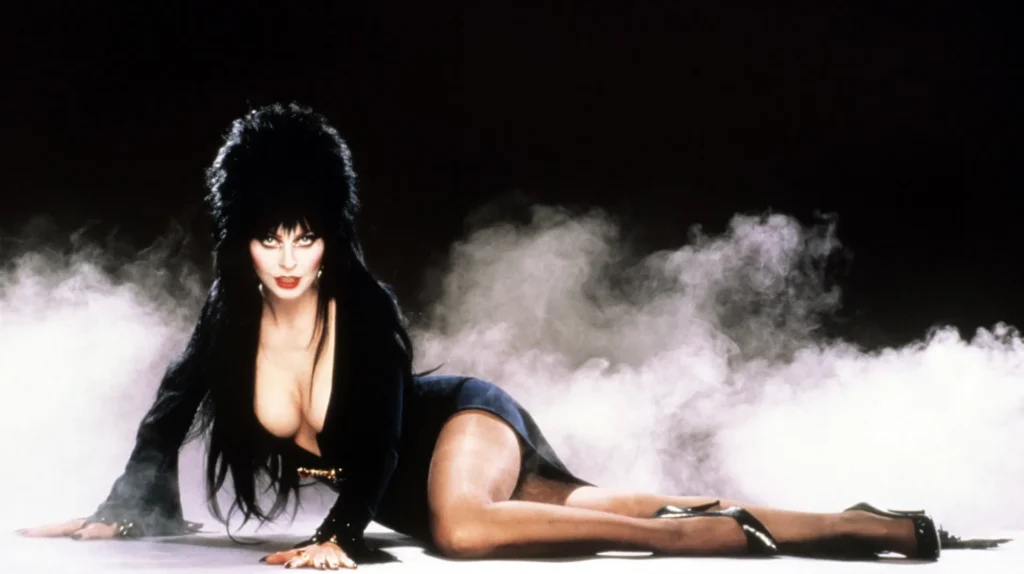The horror hostess with the mostest, Elvira is a creature of pop culture that has managed to stay relevant since her debut in 1981. The character, portrayed by burlesque dancer turned actress Cassandra Peterson, takes inspiration from past vampiric women: Morticia Addams’ seductiveness, Lily Munster’s fiery personality, and Vampira’s dark, sleek look. These traits, combined with the iconic “valley girl” persona and black bump hair, creates a Frankenstein’s monster of references that immediately resonated with viewers. Her first project was the nationally-syndicated Elvira’s Movie Macabre in which she provides commentary on cheesy B-movies. It gained her widespread fame and led to appearances on late night talk shows, commercials, and eventually . . . a movie.
First off, credit where credits due: Cassandra Peterson is a star. Elvira was her break into the mainstream, so by extension this movie is her first starring role in Hollywood. You wouldn’t know, because her comedic timing and mannerisms are captivating to watch. The movie focuses on Elvira quitting her job as a television host to start a Vegas residency, a very believable premise that is based on Cassandra’s own career as a showgirl in the 1970’s. Down a few thousand dollars, she heads to Fallwell, Massachusetts to collect an inheritance from her late aunt. The premise is admittedly light on plot but gives Cassandra material for some hilarious visual jokes and interactions with “straight” characters.

One of these said characters is Bob Redding. Played by Daniel Greene in what can only be described as a stoned-out stupor, he is written to be Elvira’s love interest. Emphasis on written. It feels less like a mutual attraction and more like a one-sided romance where Elvira continuously pressures Bob to go beyond first base. This is one of many common film tropes used in almost every plotline of this movie: a “different” outsider bringing change to an old-fashioned town. Whether that’s the teenage kids, religious fanatics, female rivals, or Bob Redding, Elvira manages to change them. This works to varying levels of success. Bob has a relationship with Elvira since his introduction, but is noticeably afraid of doing the deed. He runs away, stalls, or changes the subject whenever she makes advances. Only after Elvira saves him from a “monstrous main dish” does Bob finally give in. The problem is that the performance is so one-note that nothing truly changes after this main plot point, so the viewers lose interest as the story turns focus to the film’s climax.
For every protagonist, a story has a antagonist. In this case, it’s several. Elvira: Mistress of the Dark manages to introduce three distinct villians into the short runtime of 90 minutes. They all fit roles commonly found in both horror and comedy movies from the 1980’s. Vincent Talbot, Elvira’s uncle who is vying for her newly-inherited spellbook, fits the mysterious old man archetype popularized by actor Vincent Price (who the character is named after). Chastity Pariah, a town councilmember and traditionalist who opposes Elvira’s arrival, is referential of the Republican takeover in American politics during the 1980’s and the rise of televangelists like Tammy Faye Bakker. And finally, Patty is Elvira’s rival who is reminiscent of the villians in the teen flicks by John Hughes. All these characters vary in motive and have differing interactions with Elvira. Vincent Talbot is an uptight character who’s only addition to the film’s comedy is at his own expense. William Morgan Sheppard plays him exactly how you would expect, with an air of sophistication and a insatiable drive for power. On first watch I wasn’t a fan, but on subsequent viewings I realized the character provides a moment of ease between the rapid-fire jokes. Patty is a similar character who I was indifferent towards when first watching the film. She sees Elvira as a threat to her efforts at seducing the local men and makes it her mission to sabotage her romance with Bob. Of the three villians, Patty is the least featured. She pops up from time to time to react to Elvira before disappearing. At the conclusion of the movie, Patty is revealed to be flat-chested (GASP!) and using padding to try and draw Bob from Elvira. She then apologizes for her actions and realizes that Elvira isn’t a monster just for being more sexual. It is a satisfying ending to her plotline and makes a great statement about accepting people that are different than you. Finally, my favorite villain of the movie: Chastity Pariah. Played by character actress Edie McClurg, this performance is the only one that reaches the comedic highs set by Cassandra Peterson. For every iconic line Elvira has, Chastity has an even more iconic rebuttal. She manages to play an egomaniac who switches between fake sweetness to devilish insults with ease. One of my favorite scenes happens during the last thirty minutes of the movie, when Elvira plants an enchanted entrée among a table of food at a church potluck. It has an aphrodisiac effect that turns the adults into crazed lovers. Chastity goes absolutely crazy, spewing inappropriate jokes at the speed of light. I loved it so much, even more when in the next scene she denies all of it and blames her fellow councilmembers for seducing her.
For a 1980’s comedy, Elvira: Mistress of the Dark holds up well. It’s infinitely requotable, undeniably iconic, and an underrated gem. Even if the humor isn’t your cup of tea, at least watch this incredible finale music number with a . . . uh captivating frontal display by Elvira . . . I guess you would say.
Final Score: 3/5
